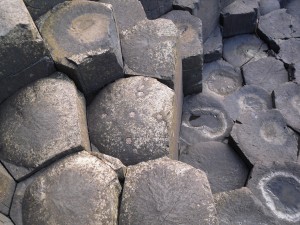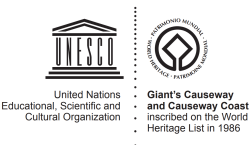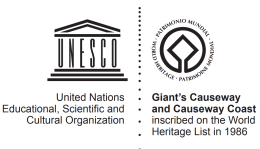As part of the Giant’s Causeway and Causeway Coast and World Heritage Site Management Plan 2013 – 2019, it was highlighted that damage had been caused to the Giant’s Causeway through rock coring practices. The Geological Survey of Northern Ireland (GSNI) and the Northern Ireland Environment Agency (NIEA) in conjunction with the National Trust have recognised this and produced a position statement to address this issue.
What is rock coring?
Rock coring is a method of extracting a cylindrical section of rock from a natural outcrop for analytical purposes. Most rock cores are taken by drilling with special drills into the rock with a hollow steel tube called a core drill. A sample is then taken from the outcrop, removed from the tube and then inspected and analysed by different techniques and equipment depending on the type of data desired.
Is rock coring essential?
Rock coring is important as it is often necessary for palaeomagnetic, geochemical and geological research. This may be carried out by a number of geologists including researchers, students or those from industry. Overall, rock coring can be an essential part of a geologists work, helping to understand better the history of rocks and landscapes.
What are the concerns?
Due to rock coring, many rock faces across the world have been despoiled by core holes, as rock sampling has become more visually intrusive. In the past, the number of samples taken was few, small in diameter and not clustered, but over time many more samples are being taken from a single rock face, with larger diameter core drills. This serious visual damage often occurs in environmentally sensitive areas and is apparent in many geological outcrops not only in the UK and Ireland, but in many parts of the world.
How does this affect the Giant’s Causeway?
Small areas of the Giant’s Causeway have been damaged by rock coring practices, most likely obtained for geomagnetic research. Whilst this damage is at present relatively unobtrusive, the site (Giant’s Causeway and Dunseverick) is an Area of Special Scientific Interest (ASSI) identified by scientific survey as being of the highest degree of conservation value under the Environment (Northern Ireland) Order 2002, and any removal of natural material from the site is a notifiable operation. Permission should be sought from the NIEA for this activity to be carried out, and so far this has not occurred so any removal of natural material can be regarded as an illegal activity.

The Giant’s Causeway and Causeway Coast is the only World Heritage Site in Northern Ireland, a status that has been awarded by UNESCO due to the Universal Outstanding Value of the geology of the site. The tourism appeal of the Giant’s Causeway is understandably substantial, attracting approximately 800,000 people per year. Therefore, aside from the obvious implications arising from status ASSI, further rock coring will result in visual damage to one of Northern Ireland’s most important geological sites both from a scientific and a tourism perspective.
What can be done to minimise any damage?
Neither the GSNI nor the NIEA encourage the removal of rock cores, but appreciate that this is sometimes necessary to further the understanding of the Earth science of a site or as part of wider research. A code of conduct has therefore been provided, based on that produced by the Geologists’ Association (GA). All applications for coring as part of legitimate geological research should be directed to the National Trust as landowners in the first instance. Advice on proposed work can be obtained by contacting the Northern Ireland Environment Agency (the body responsible for notifiable operations at designated sites) at cdp@doeni.gov.uk
Providing permission has been sought from the NIEA, the following code of conduct should be applied:
- Take cores from the least exposed face(s). Always avoid those most obviously visible when approaching a natural exposure.
- Take only the minimum number of cores necessary. Avoid making closely spaced patterns which will attract undue attention and avoid damage to structures and features important to geological interpretation.
- Refill holes wherever possible. Holes should be plugged or refilled with rock taken from fallen or loose blocks of the same material. Ideally the hole should be plugged using the outer element of the core wherever possible.
Further reading
Scottish Natural Heritage and the Geologists’ Association, 2011, A code of conduct for rock coring.
Enlander, I., 2007, Be a careful corer. Earth Science Ireland, 1. Geologists’ Association, 1989, Geological fieldwork code.
If you have any questions about this document, please contact kirstin.lemon@detini.gov.uk
To download this as a Word Document please click here – Rock Coring Position Statement.

